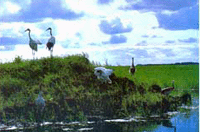| Tools: Save | Print | " target="_blank" class="style1">E-mail | Most Read |
| Heilongjiang Water Artery Helping Save Key Wetland |
| Adjust font size: |
|
By channeling huge amounts of water into a dried wetland for four years, northeast China's Heilongjiang Province has solved some problems caused by decades of pumping oil. More than 800 million cubic meters of water have been introduced into the Zhalong National Nature Reserve, close to China's largest oilfield in Daqing. The water comes from a channel from the Nenjiang River, 150 kilometers away from the reserve. The channel is part of an irrigation project, designed to supply water for Daqing, the largest oil production base in China. The reserve is the largest one of its type in the country and home to hundreds of endangered species of water fowl, fauna and flora. Around 500 flora species and 296 species of birds are found there. Home for cranes
It is estimated that there are 2,000 red-crowned cranes in the world. More than 400 inhabit Zhalong, which calls itself the hometown of the species. Set up in 1979, Zhalong is also one of the seven wetlands in China that were placed on the International Important Marsh list in 1992. Drought in recent years has made the wetland shrink a lot. A fire in 2001 turned 20,000 hectares of reeds into ash. The water covering the area shrank to about 130 square kilometers in the spring of 2001, which greatly threatened the survival of the endangered water species and seriously destroyed bio-diversity there. The Wuyuer River, the reserve's main water source, has also seen a shrinking trend because of drought and overuse of the water resources in its upper reaches. It is reported that the water flowing into the wetland in the last decade is 70 per cent less than that in the 1960s and 1970s. In a bad year like 2001, not a drop of water flowed into it. Biodiversity
This has improved the situation a lot. Water-covered area expanded to 650 square kilometers in 2002 and now it has reached about 1,100 square kilometers, which is 400 square kilometers larger than the core area of the wetland - 700 square kilometers. The wetland is recuperating now. The number of the red-crowned cranes has seen an obvious increase. According to a survey released recently, more than 70 nests of the red-crowned cranes have been seen, a 30 per cent greater number than 2001's count. Although the thirst of Zhalong is quenched temporarily, more problems remain to be solved in the future. Four years' practice has shown that it is hard to sustain the present situation by short-term water replenishment. The obvious drop in the water level of the Wuyuer River determined that the only way to provide the water needed to the wetland is through adding water supplies. (China Daily, China.org.cn, August 4, 2004) |
| Tools: Save | Print | " target="_blank" class="style1">E-mail | Most Read |
 |
| Related Stories |


